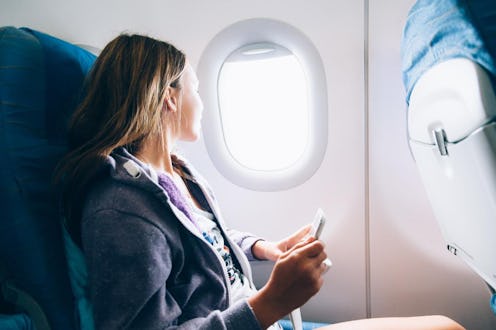
It's no secret that airplanes are a basically just steel tubes of germs hurtling through the sky. Sure, you bring hand wipes and don't touch things in the bathroom. However, the most germ-filled places on an airplane aren't where you think they are. Just like your bathroom is far from the grossest place in your home, it's also not the dirtiest place on an airplane. According to a new study from Canadian Broadcasting Corporation's Marketplace, one of the two dirtiest places on a plane is the seat-back pocket.
Flight attendants from three major Canadian airlines reportedly told Marketplace that passengers have used the pockets as receptacles for everything from used tampons, to sandwiches, to loose condoms, and dirty diapers. While that's more than enough to make you gag (especially if you put your sandwich in there on the heals of another passenger's dirty diaper), researchers found the most bacteria on the headrest.
This makes sense because these two things are probably cleaned least — especially if flights are running late and turning over passengers quickly. Basically, while the plane might look clean when you board, it's actually not. "We don't have rags, we don't have spray on board," former WestJet employee Stéphane Poirier told Marketplace. "Lots of [cleaners] are a dangerous good … so it's either water from the aircraft, or a napkin."
When it comes to flying, the old adage "don't judge a book by its cover" is applicable AF. Even though that seat looks nice and fresh, looks can be deceiving. "[Cleaning] was not a huge priority. And when it was a priority, it wasn't necessarily for cleanliness, it was for an aesthetic purpose," former Porter airline employee Connor Remus told Marketplace. Yeah, this is also how I appear organized, by throwing everything in the closet — it's a perfect illusion.
So, just what's lurking around your unclean airplane seat? The samples collected from various flights were analyzed at the University of Guelph by microbiologist Keith Warriner who said he had concerns about the types of bacteria found on these surfaces. E. coli, mold, and yeast in levels high enough to cause infections in humans were found on items you use to cover your body, places you rest your head, and surfaces you touch on the reg while in the air.
Short of boarding the plane encased in a plastic bubble, what can you do to stay safe while flying? Microban International, an antimicrobial, odor control, and surface modification company, suggested on its blog that after you touch the seat-back pocket, or anything in it, use an atimicrobial hand sanitizer. You can also clean your headrest and tray table with an alcohol wipe before you get comfy in your seat.
"With 2,155 microbes per square inch, the table tray is far dirtier than a typical airplane toilet seat, making it an extremely unsanitary surface to eat your food from," Microban International noted. "To ensure that your tray table is fresh, use a disinfectant wipe to clean the surface both before and after using it. We would also recommend putting something down (such as a clean tissue) to prevent contact between your food and the tray table."
In the Marketplace study, the tray table was the fourth most germ-filled part of the plane after the door handle to the bathroom. Additionally, airline blankets were found to contain high amounts of yeast and mold, which researchers found troubling since the blankets are in a sealed package.
While all this might be enough to keep you on the ground until you can erase this knowledge from your memory, another study published in the journal Microbial Ecology found that yes airplanes are hella dirty, but no more dirty than other public places. This is really a case of #TheMoreYouKnow. If you wipe your seat before you sit down, keep your hands clean, and avoid touching your face, you're going to be just fine.